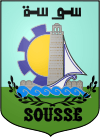Sousse
| Sousse سوسة | |||
|---|---|---|---|
| City | |||
   Clockwise from top: Skyline of Sousse, Bou Ftetah Mosque, Ribat of Sousse, Kasba, Great Mosque of Sousse | |||
| |||
| Nickname(s): "The pearl of the sahel" | |||
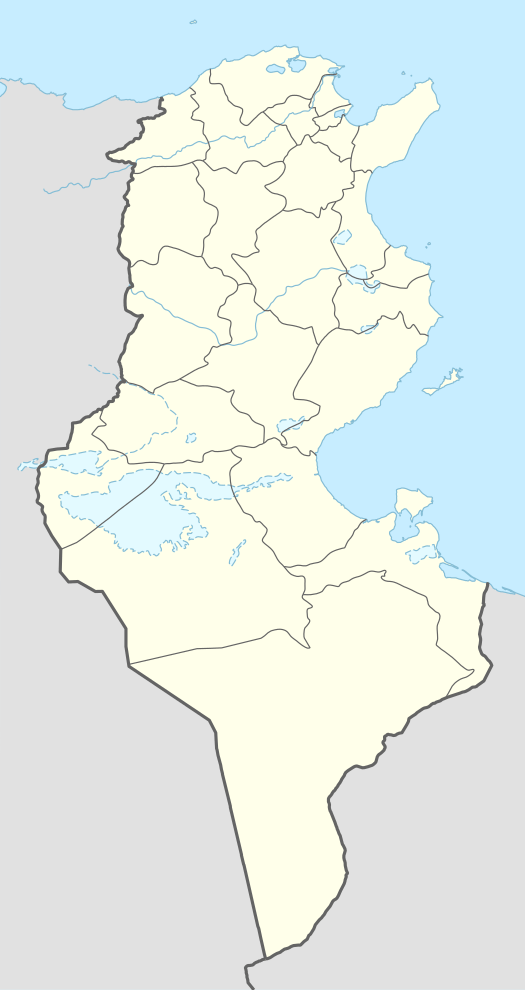 Sousse Location in Tunisia | |||
| Coordinates: 35°50′N 10°38′E / 35.833°N 10.633°E | |||
| Country |
| ||
| Governorate | Sousse Governorate | ||
| Population (2013) | |||
| • City | 271.428 | ||
| • Metro | 674.971 | ||
| Time zone | UTC+1 (CET) | ||
| • Summer (DST) | UTC+1 (CET) | ||
| Website |
www | ||
| UNESCO World Heritage site | |||
| Official name | Medina of Sousse | ||
| Criteria | Cultural: (iii)(iv)(v) | ||
| Reference | 498bis | ||
| Inscription | 1988 (12th Session) | ||
| Extensions | 2010 | ||
| Area | 31.68 ha (0.1223 sq mi) | ||
| Buffer zone | 60.99 ha (0.2355 sq mi) | ||
Sousse or Soussa (Arabic: سوسة ![]()
History
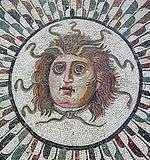
.jpg)
The Phoenicians founded Hadrumetum in the 11th century BC.
Roman and Vandal eras
The city allied itself with Rome during the Punic Wars, thereby escaping damage or ruin and entered a relatively peaceful 700-year period under the Pax Romana. Livy wrote that Hadrumetum was the landing place of the Roman army under Scipio Africanus in the second Punic War. Roman usurper Clodius Albinus was born in Hadrumetum.
As part of Bonifacius's revolt against Constantinople, the Vandals were invited in and they took Hadrumetum in 434 AD and renamed the town Hunerikopolis. During the Vandalic War Justinian retook the town in 534 and restored its Roman name.
Arab conquest
In the 7th century AD Arab-Islamic armies conquered what is now Tunisia and rapidly spread Arab culture across what had been a thoroughly Romanized and Christianized landscape. The Arabs seized the city, which in the aftermath of Rome's fall was but a remnant of its former self.[1] They renamed the city Sûsa and within a few decades elevated it to the status of the main seaport of the Aghlabid Dynasty. When the Aghlabids invaded Sicily in 827, Sûsa was their main staging ground.
After the Byzantine city of Melite (modern Mdina, Malta) was captured by the Aghlabids in 870, marble from its churches was used to build the castle of Sousse.[2]
Subsequent History
In the centuries that followed, Sûsa was briefly occupied by the Normans of Sicily in the 12th century and in the 18th century was the target of bombardments by the Venetians and the French. The French called the city Sousse.
Today
Despite the turmoil around it, Sousse's character had retained the solidly Arabian look and feel it had assumed in the centuries after Islam's wars of conquest. Today it is considered one of the best examples of seaward-facing fortifications built by the Arabs. Ribat of Sousse, a soaring structure that combined the purposes of a minaret and a watch tower, is in outstanding condition and draws visitors from around the world.
Sousse was the site of Chess interzonal in 1967 which was made famous when American Grandmaster Bobby Fischer withdrew from the tournament even though he was in first place at the time.[3]
These days, Sousse, with a population of about 200,000, retains a medieval heart of narrow, twisted streets, a kasbah and medina, its ribat fortress and long wall on the Mediterranean. Surrounding it is a modern city of long, straight roads and more widely spaced buildings.
Historical names
Through history Sousse has come under the rule of 5 major cultures. Each of those cultures gave a new or modified name to the town. Each of those names may appear in various forms. From oldest to newest some of these names and forms of spelling/transliteration are:
- Hadrumetum[4] OR Hadrumete[1] (Punic)
- Colonia Concordia Ulpia Trajana Augusta Frugifera Hadrumetina OR Hadrumetum[1] OR Hadrumentum (Roman)
- Hunericopolis[1] OR Hunerikopolis (Vandal)
- Justiniana[1] OR Justinianopolis[1] OR Iustinianopolis[4] (Byzantine)
- Susa (Berber), Sūsa (Arabic), Sousa OR Sousse (French)
As the following reference shows, the above list represents only a fraction of the spellings and transliterations of the names for Sousse which were known in 1903[5] (PDF page 366).
Archaeology
According to an ICOMOS report[1] from 1987, the siege and capture of Sousse at the end of the 7th century, by Oqba Ibn Nafîi, resulted in the total destruction of the city that incorporated the heritage of the previous thousand years of Punic, Roman and Byzantine history. The report states that no monument from this period "subsists in situ".
The official Tunisian body for matters of heritage and archaeology is the Institut National du Patrimoine Tunisie / National Heritage Institute (INP).[6] That body maintains a project known as the Carte Nationale des Sites Archéologiques et des Monuments Historiques.[7]
Roman circus
A PDF file[5] (in French), available from the site of the Institut National du Patrimoine Tunisie / National Heritage Institute (INP), containing over 400 pages from various reports and papers produced by the SOCIÉTÉ ARCHÉOLOGIQUE DE SOUSSE around 1903, contains some 10 references to the word cirque in the context of Sousse. This document makes absolutely clear that in 1903 the Roman circus of Sousse was considered the only public monument of Sousse whose location was known[5] (PDF page 204).
From the discussion in this file, and from an aerial photograph[8] it would appear certain that the Roman circus of Sousse was located, with a north-south orientation, about 1 km (0.6 mi) north-west of the walls of the medina at a location[9] which, today, is partially occupied by a sports ground.
Economy
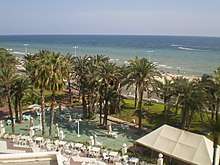

Sousse is the third largest city of the country after Tunis and Sfax.
Although Sousse is associated with olive oil manufacture and has other industries, tourism predominates today. An olive grove stretching over more than 2,500 square kilometres (965 sq mi), constitutes one of its main riches since Antiquity. A busy port, open to the town centre and adds a touch of liveliness to its activity.
Tourism
Sousse is an important tourist resort. It has a hot semi-arid climate, with the seaside location moderating the climate, making it an all-season resort with hot, dry summers and warm, mild wet winters. The fine sandy beaches are backed by orchards and olive groves.
Only 20 km (12 mi) from Monastir and Monastir Habib Bourguiba International Airport, hotel complexes with a capacity of 40,000 beds extend 20 km (12 mi) from the old city (Medina) north along the seafront to Port El Kantaoui. Some 1,200,000 visitors come every year to enjoy its hotels and restaurants, nightclubs, casinos, beaches and sports facilities.
Sousse is considered to be a popular tourist destination, especially due to its nightlife and vibrating nightclubs that will keep your head banging until the early hours. Well-known nightclubs are Bora Bora, Living, Rediguana, Platinum, the saloon.. Well known festivals fairground..The top producers and DJs in dance come and play at the various clubs. The season traditionally begins at the start of June and finishes on the first weekend of October with the Closing Parties.
On June 26, 2015 a lone gunman, later identified as Seifeddine Rezgui Yacoubi opened fire on tourists sunbathing on a beach near Riu Imperial Marhaba and Soviva hotel killing 38 and wounding 39 before being shot dead by the police.
Transport
Sousse well connected with main Tunisian Railways network having non-electrified lines to Tunis (since 1899), Sfax (since 1911) and Kasserine (since 2004) with diesel multiple unit and locomotived trains. Main Gare Sousse located as terminus in city center while Gare Kalaa Seghira serves the trains avoiding centre.
Also acting since 2010 separate electrified Sahel Metro line go to south to Monastir Habib Bourguiba International Airport, Monastir and Mahdia. This line has Sousse - Bab Jadid station as northern terminus in centre of Sousse and 4 other stations in city more.
Intercity buses and red-strip microbuses (so called louages) connects Sousse with many cities in Tunisia.
Urban transportation of Sousse presented by routes of articulated or simple buses and blue-strip louages and by cheap taxi.
Sights
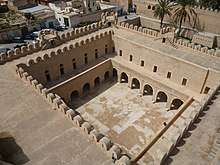
A Medina, surrounded by its city walls and fortifications, is of historical interest. The Medina includes open and covered bazaars (souks). Buildings of historical interest include the ribat castle, the central mosque, and a historical museum in the Casbah with mosaics from the area's many Roman villas. The Carthaginian catacombs can be visited.
UNESCO declared the medina of Sousse a World Heritage Site in 1988, citing among other things its preservation from modern development.
Statistics
- Population: 220,000 inhabitants (2003 estimate)
- Altitude: 2 m
- Humidity: 69%
- Number of hospitals: (private and public) 15
- Average Temperatures: (mean temperatures from May to August for the last 30 years)
- Min: 19.7 °C
- Max: 29.1 °C
- Average: 24.4 °C
- Rainfall average: May: 19.3 mm
- June: 4 mm
- July: 1.7 mm
- August: 10.3 mm
Climate
Köppen-Geiger climate classification system classifies its climate as hot semi-arid (BSh)[10] bordering with hot-summer Mediterranean (Csa).
The highest recorded temperature was 48 °C (118 °F) on August 28, 2007, while the lowest recorded temperature was 4.5 °C (40.1 °F) on December 27, 1993.[11]
| Climate data for Sousse | |||||||||||||
|---|---|---|---|---|---|---|---|---|---|---|---|---|---|
| Month | Jan | Feb | Mar | Apr | May | Jun | Jul | Aug | Sep | Oct | Nov | Dec | Year |
| Record high °C (°F) | 27 (81) |
30 (86) |
37 (99) |
36 (97) |
43 (109) |
47 (117) |
47 (117) |
48 (118) |
42 (108) |
40 (104) |
31 (88) |
30 (86) |
48 (118) |
| Average high °C (°F) | 15.8 (60.4) |
16.3 (61.3) |
17.8 (64) |
20.2 (68.4) |
23.4 (74.1) |
27.1 (80.8) |
30.7 (87.3) |
31.5 (88.7) |
30.2 (86.4) |
25.6 (78.1) |
20.8 (69.4) |
16.7 (62.1) |
23 (73.4) |
| Daily mean °C (°F) | 11.4 (52.5) |
11.7 (53.1) |
13.3 (55.9) |
15.6 (60.1) |
18.7 (65.7) |
22.4 (72.3) |
25.6 (78.1) |
26.2 (79.2) |
25.0 (77) |
20.9 (69.6) |
16.1 (61) |
12.4 (54.3) |
18.3 (64.9) |
| Average low °C (°F) | 7.2 (45) |
7.4 (45.3) |
8.9 (48) |
11.0 (51.8) |
14.1 (57.4) |
17.8 (64) |
20.6 (69.1) |
20.9 (69.6) |
19.9 (67.8) |
16.3 (61.3) |
11.5 (52.7) |
8.1 (46.6) |
13.6 (56.6) |
| Record low °C (°F) | 4.8 (40.6) |
5 (41) |
5.5 (41.9) |
5.5 (41.9) |
9 (48) |
13 (55) |
14 (57) |
20 (68) |
15 (59) |
7 (45) |
5.5 (41.9) |
4.5 (40.1) |
4.5 (40.1) |
| Average precipitation mm (inches) | 43 (1.69) |
48 (1.89) |
35 (1.38) |
28 (1.1) |
15 (0.59) |
9 (0.35) |
2 (0.08) |
7 (0.28) |
35 (1.38) |
44 (1.73) |
35 (1.38) |
53 (2.09) |
354 (13.94) |
| Average rainy days | 7 | 6 | 7 | 6 | 5 | 2 | 1 | 2 | 4 | 6 | 6 | 7 | 59 |
| Mean daily sunshine hours | 6 | 7 | 7 | 8 | 10 | 11 | 12 | 11 | 9 | 7 | 7 | 6 | 8 |
| Source #1: Climate-Data.org,[10] Weather2Travel for rainy days and sunshine[12] | |||||||||||||
| Source #2: Voodoo Skies for record temperatures[11] | |||||||||||||
| Jan | Feb | Mar | Apr | May | Jun | Jul | Aug | Sep | Oct | Nov | Dec |
|---|---|---|---|---|---|---|---|---|---|---|---|
| 16 °C (61 °F) | 16 °C (61 °F) | 16 °C (61 °F) | 16 °C (61 °F) | 18 °C (64 °F) | 21 °C (70 °F) | 24 °C (75 °F) | 26 °C (79 °F) | 25 °C (77 °F) | 23 °C (73 °F) | 21 °C (70 °F) | 18 °C (64 °F) |
Notable people
- Primasius of Hadrumetum, Roman bishop and exegete, noted for his Commentary on the Apocalypse
- Mohamed Ghannouchi, Prime Minister of Tunisia from 1999 to 2011 and self-proclaimed President of Tunisia
- Hamadi Jebali, former Secretary-General of the Ennahda Movement.
- Aymen Abdennour, footballer
- Makrem Ben Romdhane, basketball player
In films
Sousse's old city has aspects that made it ideal as a film location. Most famous is Raiders of the Lost Ark (1981), where Sousse represents Cairo, however the styles of Sousse, white-washed houses with blue details, bear no resemblance to the actual architecture of Cairo.
International relations
Twin towns – Sister cities
Sousse is twinned with:
|
See also
References
- 1 2 3 4 5 6 7 ICOMOS (International Council on Monuments and Sites) Report - The Medina of Sousse Archived 2015-07-13 at the Wayback Machine. from Site Officiel de la Ville de Sousse | Découvrir Sousse Archived 2012-01-10 at the Wayback Machine. | Histoire et Patrimoine | Sousse Patrimoine Mondial de l'humanité Archived 2011-08-27 at the Wayback Machine..
- ↑ Brincat, Joseph M. "New Light on the Darkest Age in Malta's History" (PDF). melitensiawth.com. Archived from the original (PDF) on 6 June 2015.
- ↑ The Further Adventures Of Terrible-tempered Bobby
- 1 2 BARRINGTON ATLAS OF THE GREEK AND ROMAN WORLD, Gazeteer, page 511, Map 33 Theveste-Hadrumetum, Compiled by R.B. Hitchner, 1997, in file BATL033_.PDF in B_ATLAS.ZIP Archived 2013-05-07 at the Wayback Machine. from Princeton University Press | Subjects | Browse Princeton Catalog by Subject | Archaeology and Ancient History | Archaeology and Ancient History | Barrington Atlas of the Greek and Roman World. R.J.A. Talbert, ed. Archived 2012-03-26 at the Wayback Machine. | Barrington Atlas of the Greek and Roman World, Edited by Richard J. A. Talbert | Map-by-Map Directory.
- 1 2 3 Sousse Archaeological Bulletin "SOCIÉTÉ ARCHÉOLOGIQUE DE SOUSSE, Assemblée générale du 29 Février 1903, Extraits des procès-verbaux des réunions." etc., from Institut National du Patrimoine Tunisie / National Heritage Institute (INP) | Digital Library | Sousse Archaeological Bulletin (near bottom of page).
- ↑ Institut National du Patrimoine Tunisie/National Heritage Institute (INP).
- ↑ Carte Nationale des Sites Archéologiques et des Monuments Historiques from Institut National du Patrimoine Tunisie / National Heritage Institute (INP) | Archeological Map.
- ↑ aerial photograph of Sousse from DocArtis | Progetti | TUNISIA: Projet de gestion du patrimoine culturel | Fonti documentarie | Foto aeree | PHOTOS AERIENNES | Sousse ville. | A00219.
- ↑ Wikimapia location: Sousse Roman circus (probable location).
- 1 2 "Climate: Sousse - Climate graph, Temperature graph, Climate table". Climate-Data.org. Retrieved 30 October 2013.
- 1 2 "Sousse, Tuisia". Voodoo Skies. Retrieved 30 October 2013.
- 1 2 "Sousse Climate and Weather Averages, Tunisia". Weather2Travel. Retrieved 30 October 2013.
- ↑ "Sousse, Tunisia - The pearl of the Sahel". Stadt Braunschweig [City of Braunschweig]. Retrieved 2013-08-07.
- ↑ "Sister Cities". Izmir Metropolitan Municipality. Retrieved 2015-06-30.
- ↑ "Medmestno in mednarodno sodelovanje" [Intercity and International Cooperation]. Mestna občina Ljubljana [Ljubljana City] (in Slovenian). Archived from the original on 2013-06-26. Retrieved 2013-07-27.
- ↑ "Serpukhov Region". Archived from the original on 2017-10-02. Retrieved 2009-04-15.
External links
Official:
- Sousse (Municipalité). "Portail officiel de la municipalité de Sousse" (in French). Archived from the original on 2012-01-10.
- Sousse (Municipalité). "Portail officiel de la municipalité de Sousse > Découvrir Sousse > Histoire et Patrimoine" (in French). Archived from the original on 2011-08-27. > 'Sousse Patrimoine Mondial de l'humanité' and 'Sousse dans l'histoire'
- Office de la marine marchande et des ports (Tunisia). "Port de Sousse" (in French). Archived from the original on 2008-06-04.
- Cultural portal. "Portail de la ville de Sousse" (in French).
General references and travel guides:

- LookLex. "Tunisia / Sousse".
- LookLex. "Encyclopaedia / Sousse".
- Interactive Virtual Tour of Sousse

Photographs:
Coordinates: 35°50′N 10°38′E / 35.833°N 10.633°E
| Wikimedia Commons has media related to Sousse. |

